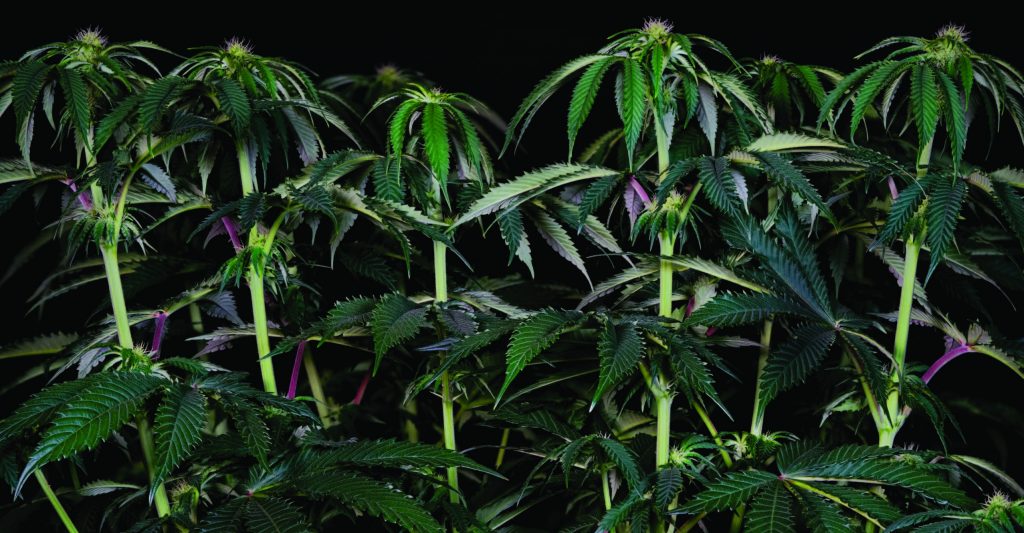Difference in Flowering from Seedling vs. Clone
What are the observable differences between a plant flowered from clone and a plant flowered from seedling? There are distinct differences when flowering a seedling (5-7 weeks from sprout) compared to a clone that has had time to mature. Specifically, you will notice a difference in flowering time, resin, terpene production, flower size, and internode length.
There are advantages to using both clones and seeds in a growing process, and flipping both can reveal otherwise hidden traits, like flowering triggers and vigor. Your end game will determine which is best for your process. Growing from seed typically results in larger flowers, longer internodes, longer flowering times, and increased vigor. When you flower that seed early, you can also benefit from a plant that needs less-concentrated feeds and possesses better pathogen resistance. Conversely, growing from clone can give you more resin, increased terpene concentration, higher flavonoid and anthocyanin concentration, as well as a faster flowering time.
HOW DO YOU TELL IF A SEEDLING IS "MATURE ENOUGH" TO FLIP?
Once a plant has reached a certain level of maturity, it will begin producing alternating (asymmetrical) growth nodes. Seeds produce parallel growth nodes initially, and with age (typically 5-7 weeks) will begin producing alternating nodes. Seedlings are incapable of flowering until they have reached this point, whereas clones begin with alternating nodes as they maintain the age of their source. As cannabis ages from seed, the plant's hormones will change, boosting ethylene production (the hormone responsible for feminine traits) which leads to a shortened flowering time and helps facilitate more distinctive expressions.
When flowering a seed while it still has parallel nodes, you'll see distinct and predictable differences in both morphology (skeleton of the plant) and morphogenesis (qualities of the flower).

Photo by: Ascent 420
ADVANTAGES TO FLOWERING FROM SEEDLING:
Flowering from seedling has its advantages, including a less demanding input regimen (lights and nutrients) as well as a stronger immune response. Seedlings flowered early require lower EC feeds (less nutrients/feed), as well as a lower uMole to achieve the same rate of photosynthesis as a mature seedling. The buds from these plants will typically have larger leaves, wider stems, and longer internodes. The colas from these plants will usually have greater depth and size as well (flowers from seed can be up to 50% larger than those from successive clone rounds). Additionally, these seedlings often present better pathogen resistance in spite of longer flowering times.
ADVANTAGES TO FLOWERING THE SAME GENETIC FROM CLONE:
Depending on your goals, starting from clone may be better suited to your needs, as it often results in increased predictability, greater distinction among plants, and shorter flowering times (even though the overall process is longer). Clones are typically more resinous than seedlings, producing higher terpene concentrations. Additionally, clones allow a plant to reach a maturity it might not have reached as a seedling, resulting in more distinctive expressions (colors, aromas, cannabinoids, and more). Plus, clones typically have a faster trigger when flipped to flower. Your preferences and space availability will determine which method is best for your goals.
IMPORTANT CONSIDERATIONS WHEN PHENO HUNTING & BREEDING:
If you are going to breed, you can gather more information by growing with both methods. I like to flower my hunts and breeding projects from seed AND THEN from clone to see how the plant behaves in both conditions. It is impossible to see the full genetic expression of a plant from seedling, even if you allow it to mature to the point of alternating nodes. From our experience, to get full distinction from a seed, it can take 10-12 weeks. Similarly, from clone you may miss desirable traits seen in seedlings, such as a quick trigger, pathogen resistance, or early onset vigor, which can be helpful in determining what cultivars are better for growing from seed.
When breeding, it is helpful to have an understanding of your genetics in both scenarios, particularly for those that will be growing from seed.

WRANK R2, Day 16 of flower, from seed. Photo by: Ascent 420